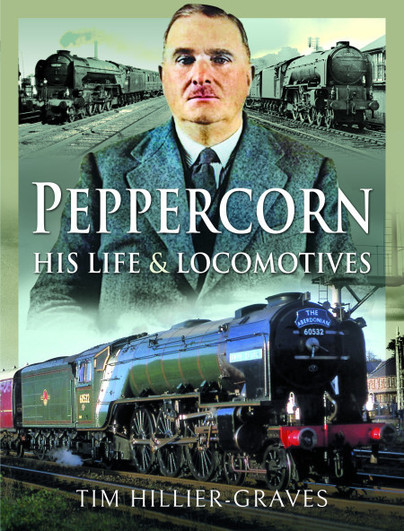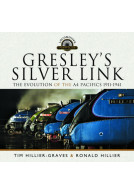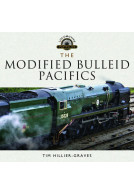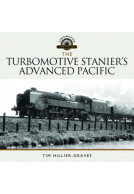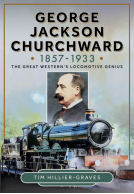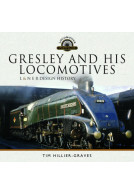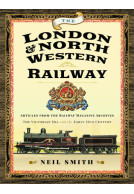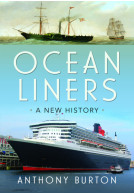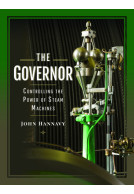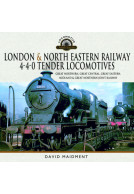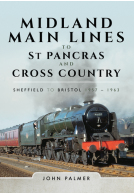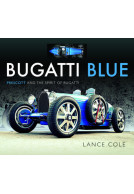Peppercorn, His Life and Locomotives (Hardback)
Imprint: Pen & Sword Transport
Pages: 264
Illustrations: 250 colour & black and white photographs and weight diagrams
ISBN: 9781526729859
Published: 29th June 2021
(click here for international delivery rates)
Need a currency converter? Check XE.com for live rates
| Other formats available - Buy the Hardback and get the eBook for £1.99! | Price |
|---|---|
| Peppercorn, His Life and Locomotives eBook (25.0 MB) Add to Basket | £19.99 |
Arthur Peppercorn, a vicar's son from Herefordshire, was the last L N E R Chief Mechanical Engineer.
He managed his department for a very short time before it was swept away in the wholesale changes that followed Nationalisation of British Railways in 1948.Although a disciple and follower of Sir Nigel Gresley, he was his own man and developed his talent for production engineering that fully complimented the design skills of his greatly respected leader.
He then became a worthy deputy to Edward Thompson during a war that demanded great personal sacrifices from both men.
When he finally became C M E in 1946 he used his wide talents and experience to lead in developing two successful pacific classes of locomotives, that many rate as being among the best locomotives of this type ever to appear in Britain.
This book, which is the first detailed biography of Peppercorn, tells his fascinating story and describes the influences on his life and career, illustrating his many achievements along the way.
I enjoyed this excellent book, it is well written, very detailed and full of technical information.
Bradford Railway Circle
A lot of technical detail that is kept readable. Well illustrated and well presented - highly recommended.
Rail Advert
4.9 / 5
Read the full review here
"This is a wonderful book on this iconic engineer of the heyday of steam on Britain's Railways. Highly recommended."
The Broad Gauge Society
The author describes Peppercorn as a facilitator rather than an innovator but in the post war world that was a skill badly needed. Personally well liked with a sense of humour his early death was a great loss to engineering but his record and achievements are righty celebrated in this book.
The Society of Model and Experimental Engineers Journal - April 22
"The author has undertaken much diligent research in what is the first detailed biography of Peppercorn. The resultant story is highly detailed, telling the story of this gifted engineer from his early days, through the Second World War years when he served as deputy to Edward Thompson to his brief but tumultuous time at the top."
ENGINEERING in MINIATURE - November 2021
Hard on the heels of his book about Edward Thompson, comes this volume by Tim Hillier-Graves on the life and career of the LNER's last Chief Mechanical Engineer, Arthur Peppercorn. This completes the author's trilogy covering all three LNER CMEs, the first of course having been about Sir Nigel Gresley published in 2020.
Phillip Benham, The Journal of the Friends of the National Railway Museum Winter 2021-2022
Peppercorn is one of these figures about which relatively little has been written, certainly not for many years, so this is a timely as well as valuable narrative. It is interesting to read that, like his mentor Gresley, Arthur Peppercorn was a 'son of the cloth' his father being a Church of England clergyman. Like Gresley, but unlike Thompson, he would shun an academic qualification going straight from school into an apprenticeship with the Great Northern Railway under Henry Ivatt. This was in 1905, the same year that Gresley joined the company as Carriage & Wagon Superintendent. From then on both men would work in the same department, until Gresley's untimely death in 1941.
Peppercorn's rise through the ranks with the GNR and then LNER is charted in as much detail as is available. He seems to have been a modest man, reflected by the fact that only rarely does he seem to have set down his thoughts and experiences, especially in his early days. However, another apprentice at Doncaster around the same time was 'W O' Bentley of motor car fame. The author quotes extensively from Bentley to give a fascinating picture of life as an apprentice in Doncaster Works during the Edwardian period. After his apprenticeship, Peppercorn's first posting was to the large engine shed at Colwick in Nottingham, and it is of note that his early career was in the locomotive running department at various locations up to and after the 1st World War. In the War, like Edward Thompson he volunteered and served in the Royal Engineers. In 1920 he moved over to workshops at Doncaster, initially running the wagon works but very soon as assistant to the Carriage & Wagon Superintendent. In fact he remained in this sphere of activity for some time, becoming Carriage & Wagon Works Manager in the early years of the LNER.
Only in 1933, when he followed Thompson as Assistant Mechanical Engineer at Stratford, did Peppercorn again beecome heavily involved in locomotive matters. Now a senior member of Gresley's team, in 1938, he took over responsibility for Darlington Works, and became well placed to become Assistant CME to Thompson following Gresley's death. However, unlike Thompson, whose appointment at CME was not announced for some time, by the time of the latter's retirement Peppercorn was the natural heir apparent to be the LNER's last CME in 1946 - a period destined to be very short as Nationalism rapidly approached.
One of the highlights of the book is a chapter summarising those few occasions when Peppercorn did put pen to paper or where his observations are on record. What emerges is someone who, despite the rigours of a tough engineering career, retained an almost boyish enthusiasm for steam locomotives and their performance. As examples, in a booklet for staff, he uses phrases such as 'As the Silver King glides to rest in King's Cross...' and talks about, 'The grimy features of the fireman' bearing 'eloquent testimony that he has not been idle'. Railway enthusiasts get most upset when the definite article is added to an engine's name, regarding it as unprofessional yet this was from the pen of someone who in a few years would be the LNER's most senior locomotive man. Here was a man who clearly felt passionately about the machines he was working with. It is also clear that he was much liked and respected by those who worked with and for him - including the many footplate men he met when 'riding out'. As a remarkable and sad aside, along with Gresley and Thompson, Peppercorn would suffer the early loss of his wife to illness - although he would (much) later remarry.
The author argues that Peppercorn was not the greatest innovator, but there is no doubt that he was an extremely competent engineer and manager - skills honed by his many years in the locomotive running department and workshop production. There is an echo here of his predecessor Edward Thompson, whose shoes he often followed on promotion. However he was not only a more modest man, but it seems also more gregarious and a good team leader. Thus it is both interesting and appropriate to see the activities and words of other senior figures in the LNER CME team recognised, such as 'Freddie' Harrison (albeit sometimes controversially), Edward Windle, David Gray, and surely the greatest stalwart of all Bert Spencer - a man whose story deserves to be told in its own right.
Much of the book looks at locomotive development throughout the period of Peppercorn's career, although it is doubtful if he was much involved in this until the mid-1930s. Thereafter he became increasingly so, if at first only at the production level, culminating in his own period as CME, where of course he will always be best remembered for the A1 and A2 Pacifics. Herein is one of the few issues I have with the book, namely that much of what is written involves a high degree of speculation in terms of Peppercorn's personal connection with events, or their impact upon him. However, I do see the author's problem where little direct evidence is available.
As with the two previous volumes on Gresley and Thompson, this is without question an important book in it's own right, reflecting much detailed and new research. When taken together, we have an invaluable record about the three men who held sway on the LNER, and for a substantial period the GNR, for nearly half a century. The reader may not agree with all the arguments put forth, especially where they are speculative, but no matter, they are invariably well made, and we can make up our own minds or be inspired to carry out our own research.
The book is well presented and illustrated with an excellent selection of well captioned photographs - many of which will not have been seen before - together with an extensive collection of locomotive line diagrams, charts, plans and records. These include performance logs for the inaugural 'East Anglian' made by Peppercorn himself! I can only echo my earlier comments, that this is essential reading for anyone with a serious interest in the development of steam traction in the 20th Century.
"This is an excellent and thought-provoking work, illustrated profusely with contemporary photographs and surviving documents."
West Somerset Railway Association
"It is recommended unhesitatingly, an excellent book in its own right but one that should perhaps be read in conjunction with the author’s books on Gresley and Thompson, truly a magnificent trilogy!"
Ffestiniog Railway Magazine - Spring 2022
Featured in
York Model Engineers Newsletter - September 2021
Review Of The Month
Steam World, October 2021
This book is a decent tribute to the LNER’s last Chief Mechanical Engineer.
The book is a very enjoyable and informative read and should find a place on the shelves of any serious enthusiast of the LNER. Highly recommended.
LNER Society
A brilliant book on this iconic engineer of the hay day of steam on British Railways. It is a comprehensive history of his life and the engines he designed. I would give this six stars and would highly recommend it.
James Simmonds
About Tim Hillier-Graves
TIM HILLIER-GRAVES was born in North London during 1951. On leaving university he served as an officer with the Royal Navy, seeing wide service on land and sea. For much of this time he specialised in weapon development projects, specifically missiles and heavyweight torpedoes, and worked alongside BAe, Marconi Space and Defence Systems and McDonnell Douglas in the process. In support of this work, he undertook prolonged periods of study and research at the Royal Naval College, Greenwich, and the Royal Military College of Science, Shrivenham. Late in his career he changed specialisms to become Head of Investigations for the MoD’s Estates Organisation. From this he moved on to become Head of Finance and Planning and then into Human Resource Management where he specialised in outsourcing to industry. Then as an Assistant Director he took on responsibility of housing for military personnel. He retired in 2011 to focus more fully on writing biographies and books related to military, aviation and engineering matters.







